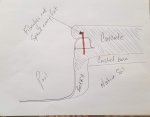some companys use 2 seperate pours, they do a collar "bond beam" around the fiberglass pool and leave it low, then pour on top with a seperate pour. Not worth it to me the monolithic pour is fine its not a huge pool and hes doing proper fill w perimeter drain around pool its not going anywhere. Not sure what your using for base, pea gravel is whats the most recommended for fiberglass, make sure and get a tamper in there on the base material, and compact in lifts, u want that sucker snug and if your shooting w a transit and screed rails you should be golden. Make sure u use spreader bar when lifting the pool, Ive seen one crack from a 4 point lift but it was much larger, be patient and make sure u walk the shell and its solid throughout, only one shot to sit it right. Fiberglass has gotten expensive, I wanted to do glass not much bigger in NJ and I was seeing 17-18k US without delivery, going steel wall w liner at this new house next month






